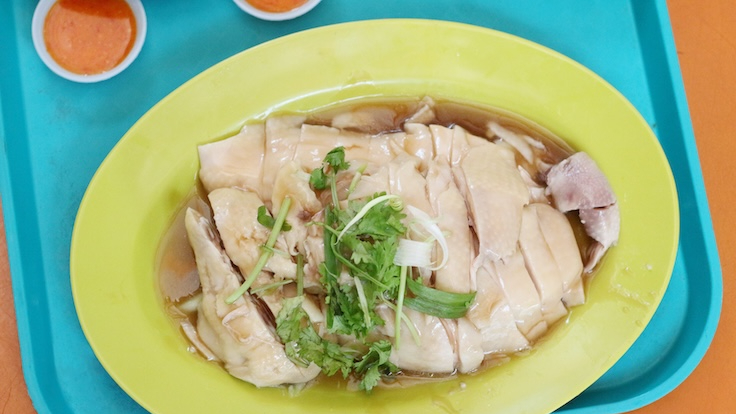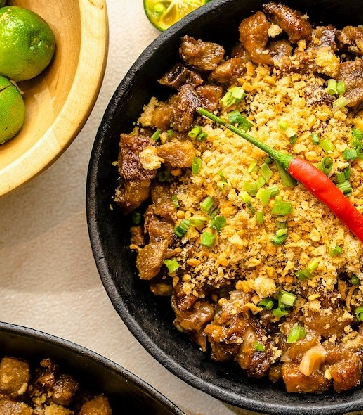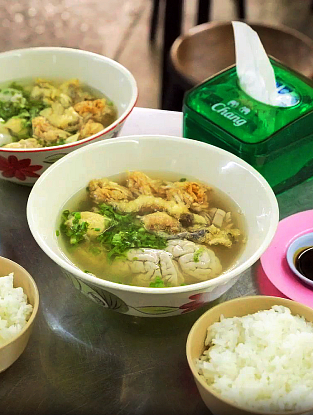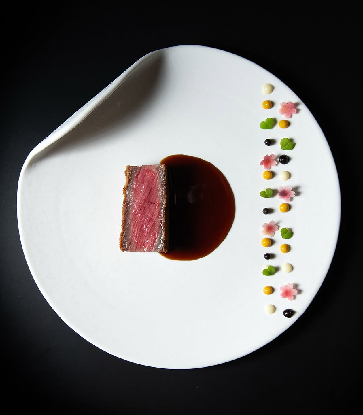Today’s highly-developed, ultra-modern Singapore is a far cry from its early days when migrants from China, India, and Southeast Asia teemed the island to seek new opportunities under the auspices of the British East India Company. Stamford Raffles had opened the floodgates when, under the Treaty of Singapore signed on 6 February 1819, he got Johore’s Sultan Hussein to grant the British the right to establish a trading post on the island.
The rusticity of present-day Singapore hawker dishes harked back to their proletarian roots in the 19th century: feeding whole generations of menial labourers who toiled to build the island. Itinerant hawkers plied the streets of Singapore, balancing their wares in baskets on shoulder poles or on rickety pushcarts, offering sustenance to the masses where they worked in the streets, and also right to the doorstep where they lived.

Consequently, hawker food are one-dish meals, designed to be consumed in situ. Even as Singapore evolved from Third World to the First in the last six decades, its hawker food culture remained steeped in the past, as the people’s taste preferences remained largely the same — rustic cooking reflects the origins of the early emigrants: the Hokkien, Cantonese, Teochew, Hakkas, and Hainanese from Southern China; the Tamils and Malayalees from Southern India; and the Malays and Javanese from the Southeast Asian archipelago.
But what a dazzlingly rich hawker food culture that we have inherited! Here are some must-try hawker food that one mustn’t miss when in Singapore:

Chicken Rice
Singapore’s Chicken Rice is nonpareil in the region, with its perfectly poached chicken and fragrant, tasty chicken-flavoured rice. Of Hainanese origin but localised to reflect local taste preferences, many hawkers on the island have perfected the art of poaching their chicken to attain the exact doneness — juicy and perfectly cooked.
The chickens are dressed in a light, subtle dressing that complements and elevates the flavour of the dish. The chicken will be artfully chopped and presented on a plate, garnished with fresh cucumber wedges and sprigs of fresh green scallions. The rice should be aromatic, slightly grainy, yet moist and flavoursome, with subtle hints of ginger, garlic, pandan, and spring onions used in its cooking.
The accompanying dip can be the make-or-break for many a Chicken Rice place: a blend of red chillies, garlic, and lime juice (or vinegar). A minced ginger dip, plus dark soy sauce, are other condiments to complete a Chicken Rice meal.
Where to find Chicken Rice in Singapore: Margaret Drive Sin Kee Chicken Rice (Bib Gourmand, MICHELIN Guide Singapore 2024), Tian Tian Hainanese Chicken Rice (Bib Gourmand, MICHELIN Guide Singapore 2024), Ji De Lai Hainanese Chicken Rice (Bib Gourmand, MICHELIN Guide Singapore 2024), Tiong Bahru Hainanese Boneless Chicken Rice (Bib Gourmand, MICHELIN Guide Singapore 2024), Boon Tong Kee – Balestier Road (Selected, MICHELIN Guide Singapore 2024)

Laksa
Singaporean Laksa is a dish that tells the story of a place — where Chinese, Malay, and Peranakan flavours collide in a bowl of noodle soup that’s both comforting and complex. Transcending beyond its purpose of satisfying hunger, it is a reflection of Singapore’s rich, multicultural heritage.
The soul of Laksa lies in its broth — a rich, spicy concoction made from coconut milk and rempah, a potent spice paste. The broth’s creamy texture and vibrant orange-red hue are the backdrop for a balance of heat and sweetness that dances on the palate. Thick rice noodles, slippery and chewy, soak up this elixir, turning each bite into a flavourful journey.
The toppings are as diverse as the Lion City itself — prawns, fish cakes, tofu puffs, maybe some cockles, or shredded chicken, or a hard-boiled egg. It’s all brought together with fresh herbs like laksa leaves and a dollop of sambal for that extra kick.
Where to find Laksa in Singapore: Heng Heng Cooked Food (Bib Gourmand, MICHELIN Guide Singapore 2024), Jason Penang Cuisine (Penang Assam Laksa) (Bib Gourmand, MICHELIN Guide Singapore 2024), Whole Earth (Bib Gourmand, MICHELIN Guide Singapore 2024), National Kitchen (Selected, MICHELIN Guide Singapore 2024)

Prawn Noodles or Prawn Mee
The Hokkiens started arriving en masse in Singapore from the 1820s, bringing along their favourite noodle dish: Prawn Noodles. This is a soup dish, as blanched yellow Hokkien wheat noodles are steeped in a savoury prawn-pork broth. Toppings include slivers of pork, whole prawns, crisp-fried shallots, and lard croutons.
Back in Fujian, China, the dish is known as “summer noodles” — a reference to the peak prawn-fishing season during summer and the popular consumption of prawn noodles during that time of the year. In Singapore, the early Hokkien emigrants would have found to their delight that the tropical climate was conducive to enjoying prawn noodles the whole year round.
Where to find Prawn Noodles in Singapore: Da Shi Jia Big Prawn Mee (Bib Gourmand, MICHELIN Guide Singapore 2024), Jalan Sultan Prawn Mee (Bib Gourmand, MICHELIN Guide Singapore 2024), Heng Heng Cooked Food (Bib Gourmand, MICHELIN Guide Singapore 2024), Soon Huat (Bib Gourmand, MICHELIN Guide Singapore 2024), Zhup Zhup (Bib Gourmand, MICHELIN Guide Singapore 2024), 545 Whampoa Prawn Noodles (Selected, MICHELIN Guide Singapore 2024)

Wantan Noodles or Wantan Mee
This Cantonese staple of supple, thin egg noodles, tossed in a tasty dressing of soy sauce, sesame oil, shallot oil, lard, and other condiments, garnished with Cantonese-style caramelised BBQ pork (“char siew”) and wantan dumplings, is one of the most popular noodle dishes in town.
Despite their similar moniker, Singapore Wantan Mee is a different animal compared to Hong Kong Wantan Mee. Whereas the Hong Kong version is soupy, and is judged by how good its complex, subtly-flavoured broth is, the Singapore version is usually served “dry”, plus some chilli paste to add a spike of heat.
Where to find Wantan Noodles in Singapore: Fei Fei Roasted • Noodle (Bib Gourmand, MICHELIN Guide Singapore 2024), Kang's Wanton Noodle (Selected, MICHELIN Guide Singapore 2024), Koka Wanton Noodles (Selected, MICHELIN Guide Singapore 2024)

Bak Kut Teh
Bak Kut Teh is a soup dish popular in Singapore that’s as comforting as a warm hug on a rainy day, but with a backbone of robust flavour. At its core, Bak Kut Teh is a peppery pork rib soup, simmered for hours to coax every bit of essence out of the bones. The result? A broth that’s clear, almost deceptively simple in appearance, but packed with a punch of white pepper, garlic, and other spices that’ll wake your taste buds up.
This isn’t your run-of-the-mill soup; it’s a bowl of history; a nod to the Hokkien and Teochew immigrants who brought the recipe to Singapore. The pork ribs, tender from their long soak in the spiced broth, are the main event, but the sides — puffy fried dough sticks, a bowl of steamed white rice, maybe some preserved vegetables — complete the experience. Dip the dough sticks into the broth, let them soak up that peppery goodness, and you’ll start to understand why this dish has such a devoted following.
There is also a version of a Bak Kut Teh where the sauce is reduced to a thick gravy and referred to as the "dry" version. Dry Bak Kut Teh is a bold, concentrated twist on the traditional soup version. The sauce, made from soy sauce, dried chilli, garlic, and other spices, is cooked down until it clings to the meat, intensifying the flavours.
Where to find Bak Kut Teh in Singapore: Joo Siah Bak Koot Teh (Bib Gourmand, MICHELIN Guide Singapore 2024), Song Fa Bak Kut Teh (New Bridge Road) (Bib Gourmand, MICHELIN Guide Singapore 2024), Hokkien Street Bak Kut Teh (Selected, MICHELIN Guide Singapore 2024), Hua Xing Bak Kut Teh (Selected, MICHELIN Guide Singapore 2024), Yong Kee Claypot Bak Kut Teh (Selected, MICHELIN Guide Singapore 2024)

Popiah
Popiah is a fresh spring roll, but don’t let that simplicity fool you. The thin, delicate wheat skin, almost translucent, wraps around a treasure trove of ingredients that deliver an explosion of flavours and textures in every bite.
Inside, you’ll find a mix of julienned vegetables — carrots, turnips, and bean sprouts — stir-fried to a tender crispness. There are also slivers of pork, shrimp, or sometimes even crab meat, adding a savoury depth. It’s all tied together with a smear of sweet, dark hoisin sauce and a bit of chili paste for heat, maybe a sprinkle of crushed peanuts or fried shallots for crunch. Popiah is usually sold together with its cousin, the Kueh Pie Tee, which shares the same fresh and vibrant vegetable mix; but instead of the wheat skin wrapper, the filling is stuffed into thin, crisp pastry cups.
Where to find Popiah in Singapore: Ann Chin Handmade Popiah (Selected, MICHELIN Guide Singapore 2024), Rojak‧Popiah & Cockle (Selected, MICHELIN Guide Singapore 2024)

Fried Hokkien Mee
This popular noodle dish makes use of two types of noodles: the yellow Hokkien wheat noodles and thick rice vermicelli, which are stir-fried in an intense, savoury prawn and pork broth. Fried Hokkien Mee is simplicity personified and proof that deliciousness depends much on the cook’s expertise and experience to attain the perfect balance of tastes and textures in one’s stir-fry.
Fried Hokkien Mee gets its umami hit from the gradual addition of prawn-pork broth during the cooking process, similar to the cooking of risotto, where the broth is added bit by bit, to be absorbed gradually. The cooked noodles, plump with flavour, will be garnished with shrimps, pork slivers, squid rings, and strips of egg omelette. Calamansi lime and a dollop of chilli paste completes this addictive dish.
Where to find Fried Hokkien Mee in Singapore: Hong Heng Fried Sotong Prawn Mee (Bib Gourmand, MICHELIN Guide Singapore 2024), Ah Hock Fried Hokkien Noodles (Selected, MICHELIN Guide Singapore 2024), Come Daily Fried Hokkien Prawn Mee (Selected, MICHELIN Guide Singapore 2024), Hokkien Man Hokkien Mee (Selected, MICHELIN Guide Singapore 2024), Sheng Seng Fried Prawn Noodle (Selected, MICHELIN Guide Singapore 2024)
RELATED: 11 Singaporean MICHELIN Chefs Tell Us Their Favourite Hawker Dishes and Where to Enjoy Them

Fried Carrot Cake
The oft-heard Carrot Cake in Singapore is actually radish cake pudding (”chai tow kway”), steamed, and then cut into cubes before being griddle-cooked in lard, preserved and salted chopped radish ("chai poh"), garlic, eggs, and soy sauce. Frying the Carrot Cake over intense heat in lard gives the dish an intense “wok hei” (“seared fragrance”) aroma and taste. The caramelised exterior contrasts beautifully with the moist, polenta-like texture of the Carrot Cake.
Of Teochew origin, Fried Carrot Cake comes in two versions: a white one and a dark one, which has the addition of sweet, dark soy sauce. Both are delicious in their own way, and many stalls now offer both types on a single plate.
Where to find Fried Carrot Cake in Singapore: Chey Sua Carrot Cake (Bib Gourmand, MICHELIN Guide Singapore 2024), Fu Ming Cooked Food (Bib Gourmand, MICHELIN Guide Singapore 2024), Heng (Bib Gourmand, MICHELIN Guide Singapore 2024), Guan Kee Fried Carrot Cake (Selected, MICHELIN Guide Singapore 2024)

Bak Chor Mee
Bak Chor Mee, or minced pork noodles, is another popular noodle dish that is of Teochew origin. Consisting of springy egg noodles tossed in a tangy, vinegary dressing and garnished with minced pork, pork balls, slivers of pig’s liver, crisp shards of leatherjacket fish, and braised mushrooms, it’s the ultimate Singaporean comfort food.
Where to find Bak Chor Mee in Singapore: Hill Street Tai Hwa Pork Noodle (One MICHELIN Star, MICHELIN Guide Singapore 2024), Ru Ji Kitchen (Bib Gourmand, MICHELIN Guide Singapore 2024), Tai Wah Pork Noodle (Bib Gourmand, MICHELIN Guide Singapore 2024), Shanyuan Teochew Kway Teow Mian (Selected, MICHELIN Guide Singapore 2024)

Chwee Kueh
Chwee Kueh is the kind of dish that doesn’t shout for attention, but once you try it, it lingers in your memory like a catchy tune. It’s a humble breakfast staple — or snack, a steamed rice cake that’s soft, almost silky in texture, made from a simple batter of rice flour and water. These little cakes are served in bite-sized portions, making them easy to devour.
But the magic of Chwee Kueh isn’t in the rice cake itself — it’s in the topping. A generous spoonful of preserved radish, or chai poh, cooked in oil with garlic and sometimes dried shrimp, is heaped onto each cake. This topping is salty, slightly sweet, and carries an umami punch that transforms the plain rice cake into something extraordinary. The contrast between the soft, neutral cake and the rich, flavourful topping is what makes chwee kueh so addictive.
Often found at hawker stalls where the same recipe has been perfected over decades, Chwee Kueh is a simple pleasure, usually eaten with a side of chili sauce for those who crave a bit of heat.
Where to find Chwee Kueh in Singapore: Jian Bo Tiong Bahru Shui Kueh (Bib Gourmand, MICHELIN Guide Singapore 2024), Bedok Chwee Kueh (Selected, MICHELIN Guide Singapore 2024), Ghim Moh Chwee Kueh (Selected, MICHELIN Guide Singapore 2024), Jian Bo Shui Kueh (Selected, MICHELIN Guide Singapore 2024)

Fish Soup
At its core, Fish Soup comes with a clear broth that’s been gently coaxed into something special, often simmered with fish bones, ginger, and sometimes a hint of fried shallots to build that delicate flavour base.
The star of the show is, of course, the fish — usually slices of fresh, firm white fish like mackerel or pomfret. The fish is added just before serving, so it remains tender and flaky, never overcooked. Alongside the fish, you might find tofu, and a handful of leafy greens like Chinese cabbage or spinach, adding layers of texture and subtle bitterness to the bowl. The beauty of this dish lies in its simplicity; every element has its place, nothing is superfluous.
What makes this dish stand out is how it manages to be both light and satisfying. You can customise it as well to your liking — maybe a bit of evaporated milk for creaminess, some rice, porridge, or bee hoon (rice noodles) to make it heartier, and always a dash of white pepper or a squeeze of calamansi lime to brighten things up.
Where to find Fish Soup in Singapore: Chef Kang's (One MICHELIN Star, MICHELIN Guide Singapore 2024), Beach Road Fish Head Bee Hoon (Bib Gourmand, MICHELIN Guide Singapore 2024), Han Kee (Bib Gourmand, MICHELIN Guide Singapore 2024), Kwang Kee Teochew Fish Porridge (Bib Gourmand, MICHELIN Guide Singapore 2024), Song Fish Soup (Bib Gourmand, MICHELIN Guide Singapore 2024), Tai Seng Fish Soup (Bib Gourmand, MICHELIN Guide Singapore 2024), Ron Sheng Fish Head Bee Hoon (Selected, MICHELIN Guide Singapore 2024)

Satay
Satay comprise skewers of marinated meat — usually chicken, beef, or mutton — grilled over an open flame until they’re smoky, charred, and irresistible. The marinade is a blend of spices, turmeric, lemongrass, and sometimes a touch of sweetness from palm sugar, seeping into the meat and giving it that deep, complex flavour.
Satay in Singapore is a whole experience. The skewers come with a side of chunky peanut sauce, rich and savoury with just a hint of sweetness and spice. You dip the satay into the sauce, and, alongside, there’s usually a serving of ketupat, little compressed rice cakes, and a handful of raw cucumber and onion to cut through the richness. Satay stalls also usually serve grilled chicken wings, too.
Where to find Satay in Singapore: C.M.Y. Satay (Selected, MICHELIN Guide 2024), Chomp Chomp Satay (Selected, MICHELIN Guide 2024)






















